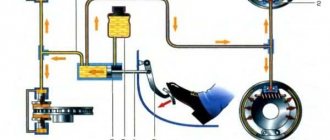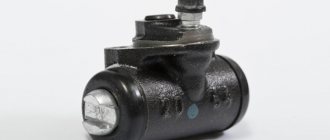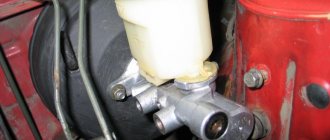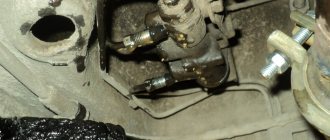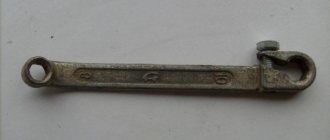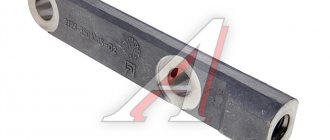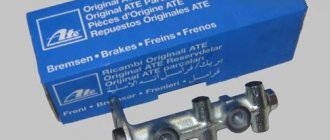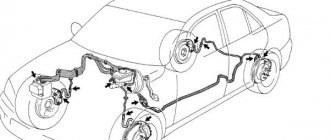A smooth or sharp drop in the brake pedal, or its floating and vibration when braking, usually indicate Master brake cylinder malfunction. Most often, the reason for its malfunction is the loss of tightness of the rubber sealing cuffs or improper operation of the bypass valves.
To distinguish its malfunctions from other malfunctions of the brake system and find out how to check whether the master cylinder is working, read the article.
Possible malfunctions of the master brake cylinder. List of problems and methods of action
Let's find out what could be causing your brake master cylinder to fail.
First of all, its breakdown occurs due to the fact that the brake fluid is unevenly distributed inside the mechanism. The cylinder itself consists of two working sections, each of which is responsible for braking one of the front wheels, as well as the rear one, located on the opposite side. You should know that in rear-wheel drive cars the picture is completely different: the sections are responsible for the operation of the brakes, which are located along the axes.
The work of the GTZ itself begins from the moment the pedal is pressed. If a vacuum booster is provided in the design of the car, then the brake cylinder contains 3 chambers, one of which converts pressing the brake into pressure, which makes it lighter. By pressing the pedal, a certain load is transferred to the piston section, which forces the brake fluid to press on the caliper. This, in turn, compresses the brake discs through the pads.
Video on the topic
Problems that arise with the brakes while traveling are considered critical and must be corrected immediately. The culprit of the malfunction is often the main cylinder, installed in the engine compartment and rigidly connected to the pedal.
To find out the cause of the breakdown and repair the unit yourself, you need to know the structure of the brake master cylinder (MBC) and its principle of operation. During the diagnostic process, it is necessary to distinguish and filter out problems with other elements of the system.
| The content of the article: |
About checking the GTZ
Malfunctions of the master cylinder may require repair or complete replacement. It is recommended to start checking the brake cylinder with an external inspection. It is necessary to carefully check it for external defects and leakage of brake fluid. After a visual inspection, you need to check the operation of the brake pedal. To do this, you need to press on it and make sure that it does not jam or fall through.
As for the master cylinder, it can not only wear out, but also become rusty from the inside over time. This often happens due to the fact that the brake fluid contains oxygen and water in certain quantities.
The cylinder is designed in such a way that if brake fluid leaks from the first section, the other will remain in working condition. That is, the first piston will pass through its own section and give movement to the second piston, which in turn will create the necessary level of pressure for the operation of its own section.
If the second section leaks
, then the first trigger will look completely different. When the piston operates in a good section, the piston from the faulty one is drawn into operation. That, in turn, moves forward unhindered and rests against the movement limiter, thereby blocking the outlet. In turn, the pressure in the first section increases, which entails braking of the wheel mechanisms.
As a result, when you press the brake pedal, it falls through. In this case, braking efficiency is observed only at the end of the pedal stroke.
Failure of the gas turbine engine and its replacement
One of the common reasons why the brake master cylinder fails is its depressurization. In practice, this is noticeable to the naked eye: the brake cylinder will constantly leak, leaving a characteristic mark and a specific smell. The level of brake fluid in the reservoir will continuously decrease. All these signs indicate the need to repair the gas turbine engine and prevent irreparable consequences.
Depressurization of the brake cylinder
is a good reason to replace it with a new mechanism. Malfunctions of the master brake cylinder such as damage and severe wear of the piston seals, inlet collar, piston return spring, as well as scuffing and severe wear of the mechanism mirror indicate mandatory repair or complete replacement of the turbocharger.
Your life and safety depend on the proper operation of the braking system. Therefore, when the above symptoms appear, it is necessary to urgently eliminate the malfunction so that there is no sudden brake failure on the road.
The structure of the master brake cylinder and 5 main signs of its failure
When purchasing a car, every person realizes how complex a mechanism he will have to operate. All mechanisms and elements have their own design purpose. In particular, the brake master cylinder (MBC) is responsible for converting pressure on the brake pedal into hydraulic pressure, which starts the braking process of the car. This functionality is provided by the supply of hydraulic fluid, which has a high boiling point. Every motorist needs to know the design of the GTZ in order to correctly understand the causes of failures.
Maximum brake reliability and an increased level of safety in modern cars is achieved by installing 2-section master cylinders. Since the intra-cylinder circuits are practically independent of each other, it is partially ensured that the brake remains operational in the event of depressurization of one of them. The single-chamber system has actually gone into oblivion due to the impossibility of distributing mechanical force to all chains so that the car does not lose controllability.
Prevention Tips
If you follow these simple recommendations, you will extend the life of your brakes:
Change the fluid promptly;
Select the working solution (PP) in accordance with the vehicle passport;
Check your PP level weekly;
Before each trip, inspect all elements of the system for leaks;
After problems with the system, do not forget to adjust the pedal;
The following need constant monitoring:
To fix serious problems, be sure to contact professional auto mechanics.
You can find a workshop suitable for location, list and cost of services on the aggregator website Uremont.com.
Brake master cylinder device
The braking system of models of the domestic automobile industry and foreign cars works almost identically; if there are differences, they are insignificant. Having understood the principle of operation of the main brake cylinder in one brand of car, you can “communicate on a first-name basis” with others.
The GTZ itself is attached to the vehicle's vacuum booster, if available. Main elements inside the case:
- reservoir (brake fluid reservoir);
- sealing collars (to each piston);
- piston (2 pcs.);
- return springs;
Some car models are additionally equipped with an indicator to monitor pressure differences within the circuits. In cross-section, the cylinder looks like a structure consisting of two sections, each of which is responsible for the normal braking of all wheels, but only in the exact opposite direction from the body.
Device
The GTZ includes:
- a housing with fittings supplying fluid from the supply tank and discharging it to the lines of the working cylinders;
- pistons of the primary and secondary circuits;
- sealing rubber cuffs located in the piston grooves;
- return springs that compress when the pistons move;
- a boot covering the entry point of the rod from the VUT or pedal into the recess on the back side of the first piston;
- a screw plug that closes the cylinder from the end, by unscrewing which you can assemble or disassemble the cylinder.
Compensation holes are located in the upper part of the cylinder body; they can overlap when the pistons move, separating the high-pressure cavity and the supply tank with a supply of liquid.
On the subject: What is a brake caliper and how does it work (types, device, repair)
The tank itself is usually attached directly to the cylinder through sealing collars, although it can be moved to another location under the hood, and the connection is made through low-pressure hoses.
The operating principle of the GTZ in simple words
The process is activated by pressing the brake pedal. The result of mechanical force is a load inside the cylinder, carried out using a rod. It directs the pistons along the desired path, overcoming the force of the return spring. The movement of the pistons is accompanied by the closure of the compensation channels, which causes the opening of the bypass channel and sealing of the entire circuit.
At the same time, pressure is created that drives the caliper. Part of the liquid flows into the pipelines, activating the vehicle, the other pushes the second piston, which, when moving, performs the same functions.
The calipers compress the brake discs with the help of the pads, and the car stops. The pistons return through the compensation hole to the initial position after depressing the brake pedal. The initial mode of the pistons inside the circuits is established by the action of springs. Having returned to their original position, the pistons again open the compensation channels, thereby equalizing the pressure in the vehicle. The waste liquid slowly flows back into its reservoir.
Causes of malfunction in the GTZ device
If there is a leak in one of the circuits, the pressure between the primary and secondary cylinders is lost. This leads to the fact that the GTZ functions as if it had only one circuit. The pusher will begin to move both pistons in the good circuit until the piston of the faulty one reaches the end of the cylinder body. Accordingly, the required pressure will be ensured in the depressurized chamber. If the idle mechanism is properly adjusted, the vehicle will effectively slow down the vehicle even in conditions of its inferiority.
Here are some signs of a malfunction in the GTZ device:
- depressurization of the cylinder is determined by the presence of a leak in the body and a specific smell;
- brake pad wear is characterized by a characteristic squeak and leakage of brake fluid;
- jamming of the regulator, which distributes the brake force. In this case, it is necessary to clean the cylinder body. There is a low threshold of sensitivity of the brake pedal; it has to be literally “sunk” into the floor;
- the pedal falls to the floor - this damage occurs due to non-working pistons. If they are not able to generate the required pressure, then the pads cannot compress normally;
- An increase in the brake pedal travel is a sign that the vehicle has become airy. Operating a car in this condition is dangerous, since there is a high risk of overheating the vehicle to the point of boiling. Pumping will help eliminate this problem.
Replacement and repair of GTZ - some points
The recommendation for carrying out repair work on this element is simple - it is easier to replace it completely if a banal replacement of rubber seals is not required. The most common reason for incorrect operation of the brake cylinder is leakage of hydraulic fluid, therefore it is necessary to periodically check the joint of the brake cylinder.
In the absence of external mechanical damage, it is necessary to replace worn-out spare parts, making sure to wash the repair parts with isopropyl alcohol. The presence of swollen cuffs may indicate low quality brake fluid, so it is worth changing it too.
The parameters of the pressure regulator are set by the manufacturer, therefore independent adjustment and repair work is prohibited!
The car owner himself decides whether to repair the brake master cylinder personally or contact specialists. However, before drawing conclusions, the cause of the failure should be determined. How to check the brake master cylinder?
- You should pay attention to the instrument readings on the panel. As a rule, they promptly notify about problems that have arisen using indicators.
- When an alarm signal appears, you need to check for fluid leaks.
- Inspect the joints and outlets of each GTZ circuit.
- Check the pressure inside the vehicle.
If the test result reveals the cause of the brake malfunction, then urgent measures must be taken to eliminate it. If you couldn’t find the root cause on your own, but the problem remains, you should seek qualified help. In most cases, it is enough to clean or bleed the turbocharger. Replacing it entirely is provided in case of depressurization of the housing or damage to the piston.
Signs and malfunctions of the master cylinder
Welcome, friends, to the DIY auto repair website. The braking system of cars consists of a whole group of components, each of which takes on a specific function. In this case, one of the most important elements is the brake master cylinder. Thanks to its action, the force applied to the system takes the form of hydraulic pressure.
Malfunctions of the main brake cylinder
Malfunctions of the master cylinder can lead to a number of negative consequences. For example, the brakes may become less effective or fail. To avoid these problems, every driver should know how to recognize and fix the problem.
What parameters of the brake system are checked on the stand?
There are two types of brake diagnostics: road and bench.
Road is used to calculate:
braking distance length;
car stability when braking;
brake response speed;
the maximum possible slope of the road on which the car can stand.
The bench method is used to calculate:
specific braking force;
coefficient of uneven braking capabilities of wheels.
The work is that sensors record reactive moments. Thanks to the recorded data, you receive accurate information about the condition of each vehicle element.
How does GTZ work?
The operating principle of the GTZ is based on the ability of a liquid to maintain its “shape” under the influence of a certain pressure. In this case, the devices structurally consist of a 2-section main cylinder, each section of which has its own hydraulic circuit.
Front-wheel drive vehicles consist of circuits that connect the braking systems of the rear and front wheels in a criss-cross pattern. For example, the right rear wheel is connected to the left front, and the left rear is connected to the right front.
Things are different on rear-wheel drive cars, where the contours are formed differently. So, one of the circuits works on the two front wheels, and the second on the rear wheels.
The GTZ is mounted on the housing of the vacuum amplifier. In this case, the working fluid is poured into a 2-section tank located above the main cylinder. The connection of the tank with the GTZ is ensured thanks to special holes.
To simplify maintenance, the walls of the tank were made of translucent plastic, which allows you to visually keep the level of the working fluid under control. As soon as the level drops below the normalized value, the sensor gives a signal to the control panel and the light comes on.
In the GTZ housing itself there are two pistons, which are mounted one after the other. The first has a free location, and the other, on the contrary, is fixed and touches the rod part of the vacuum amplifier.
In order to increase reliability, the pistons are sealed with rubber cuffs. The pistons are returned to their original position using special springs. By the way, they are the ones who hold the pistons in their original position.
As soon as you press the pedal, the vacuum booster is pressed in through the rod. Moving along the cylindrical cavity, the rod closes the hole for compensation. As a result, the pressure in the 1st circuit increases, driving the 2nd piston. The result is an increase in total pressure in the 2nd circuit.
At the moment the pistons move, empty areas are formed, which are filled with the working composition. Brake fluid is supplied through a special hole. The movement of the pistons is carried out until the return spring fulfills its functions.
GTZ disassembled
In each of the circuits, the pressure level increases to a maximum, which brings the mechanism into working condition. After the car stops and the pedal is released, the pistons return to their original position. In this case, the pressure level in the circuit is equalized and becomes similar to atmospheric pressure.
The missing air is drawn in through a special hole for compensation. When the piston moves in the opposite direction, the working fluid is squeezed back into the tank.
The advantage of a loop system is that if one loop fails, the other continues to perform its functions. For example, if there is a leak, it will manifest itself as a deeper “sink” of the pedal, but the brake performance will still remain at a high level.
Main malfunctions of the turbocharger and brake system
In order to diagnose the breakdown in time and fix it, it is important to know the signs of a malfunction in the master cylinder.
1. Severely worn pads or a leak of working fluid in the brake system can cause a decrease in its level. As a result, operation of the vehicle is prohibited until repair work is completed.
It is important to carefully examine the condition of the brake system pipes, assess the condition of the turbocharger, check the working cylinders, connecting hoses and calipers. If a leak is detected, the damaged unit must be replaced.
2. If the turbocharger becomes jammed or fails, braking efficiency may decrease, and the risk of “softening” the brake is high. This occurs due to a decrease in working fluid in the system or air entering it. The situations described above are also possible when the liquid boils.
If the brakes, on the contrary, become too hard, there is a high risk of damage to the brake booster or the vacuum booster control valve, and there may also be some problems with the vacuum hose.
3. The brake pedal travel increases. The malfunction can be caused by poor brake adjustment, the presence of air in the system and failure of the brake cylinder.
It is forbidden to ignore this symptom, because there is a high risk of complete failure of the brake system. In addition, a malfunction of one of the cylinders can cause the brake to fail.
4. Uneven braking or a sharp decrease in the efficiency of the braking system. There may be several reasons for this problem. One of them is the ingress of working brake fluid or lubricant onto the surface of the pad.
If, when you press the brake pedal, the vehicle begins to deviate in one direction or the other, this indicates that dirt has gotten on the brake pads or that the master cylinder has failed. Another likely cause of the problem is worn discs or brakes.
Symptoms of problems
The fluid brake system consists of many parts that can become unusable: pipes, wheel cylinders, calipers, drums and pads. Typical signs of a faulty master cylinder:
- After pressing the pedal, the car stops slowly. The reason is that the cuffs of one or two pistons have lost their tightness - they have cracked or “floated”.
- To slow down, you need to press the brake pedal hard. The phenomenon occurs due to swelling of the rubber of the piston seals.
- The brake pedal travel is too short. The fluid inside the cylinder has nowhere to go because the compensation hole is clogged. Another option is that the passage is blocked by a swollen rubber seal.
- A common symptom is pedal failure, the brakes coming on at the end of the stroke. This indicates complete wear of the cuffs; as a result, liquid penetrates behind the piston and rushes into the expansion tank - the cylinder “bypasses.”
- The pads do not release the brake discs and drums and get very hot when driving. Options: one of the pistons is jammed or the bypass hole is clogged.
The listed symptoms of a GTZ malfunction are similar to malfunctions of other elements. Pedal failure also occurs when a large amount of air enters the tubes or loss of fluid in one of the working cylinders. Sluggish deceleration and increased force on the pedal are often caused by a breakdown of the vacuum booster - a cracked membrane or a lack of tightness at the joints of the hose that takes off engine vacuum.
There are signs that clearly indicate the performance of the main hydraulic cylinder and the malfunction of other elements:
- during braking, the car pulls to the side - the problem lies in a certain circuit or wheel;
- jamming of the brake mechanisms of one wheel;
- creaking and squeaking when braking;
- heating the discs and pads on one wheel.
If you eliminate these symptoms, it will become easier to check the brake master cylinder in a garage. This also includes obvious brake fluid leaks and the knocking sound of worn calipers.
Diagnostic features
The first thing you need to pay attention to is the readings on the dashboard. As a rule, they react to a malfunction earlier than you are able to diagnose it during operation. So, if there are problems in the brake system, then the corresponding lamp should light up on the dashboard.
When the first signals of a malfunction appear in the brake system, the first thing you need to pay attention to is inspecting the brake cylinder (there should be no obvious signs of leakage on it).
In addition, pay attention to each of the brake circuit outputs, joints, and so on. After an external inspection, check the pressure in the brake system (this can be done using a special pressure gauge).
The pressure obtained during the measurement process is compared with what the car manufacturer recommends. If the measurements show a serious difference, then we can talk about the failure of one of the circuits. It is also worth checking the tightness of the circuit, but this work can only be done with special equipment.
As practice shows, one of the main reasons for the breakdown of the gas turbine engine is its depressurization. This is easy to notice by the appearance of a leak and a characteristic odor. Damage to the housing, failure of the return spring, wear of the cuffs (sealing and inlet) or the assembly mirror - all this is a reason to replace the master cylinder.
Knowing how to identify a faulty brake master cylinder can help you identify the problem early, fix it, and eliminate any risk to life. Good luck on the roads and of course no breakdowns.
Fault diagnosis: how to do it?
As a rule, if there is a problem with the brake system, a corresponding signal appears on the dashboard. After detecting the indicator, the motorist must visually check the master cylinder body for problems. In this case, you need to inspect it for leaks, and also pay special attention to the places where the pipeline and circuit outlets connect. After completing this activity, you should measure the pressure in the circuits using a pressure gauge. after which the measurement results must be compared with control parameters, which are usually contained in the vehicle operating instructions. If there is a difference in these readings, then this will be a sure sign of a violation. As for the tightness of the device, it can only be checked on a special stand. Therefore, in this case, you will have to seek help from specialists.
Brake master cylinder: what is it and how does it work?
Vehicles include a large number of elements that ensure full operation. Needless to say, among such systems there are no insignificant ones. Especially when it comes to the braking system, which directly ensures driver safety.
The main brake cylinder can easily be called a key part in the brake hydraulic drive circuit. Therefore, they try to make the GTZ as reliable as possible. And yet, malfunctions can only be prevented by timely prevention, since without maintenance, sooner or later any system in a car stops working.
What is a brake master cylinder and what is it for?
Brake master cylinder and reservoir.
Braking is accomplished by pressing the pads against the disc. This is done by pistons that are driven by a hydraulic system containing brake fluid. However, for brake mechanics to work, pressure must be somehow transmitted by pressing the pedal. For this purpose, a master brake cylinder is needed, which transmits the mechanical action of the driver to the hydraulic system through a booster.
Considering the importance of the part, they try to make it as reliable as possible. But even greater reliability can only be ensured by an additional system, which is why all modern cars have a two-section GTZ. Each section serves an independent circuit, which, in the event of a breakdown of the first, will be duplicated, although with less efficiency.
The circuits can be connected in the following ways:
- Parallel (4+2). One circuit is used for all wheels and has insurance on the front ones.
- Parallel (2+2). One circuit is responsible for the front wheels, the second - for the rear.
- Diagonal (2+2). Each circuit operates on one front and one rear wheel diagonally.
As a rule, a diagonal system is used in front-wheel drive cars, and a parallel 2+2 in rear-wheel drive cars.
How does a brake master cylinder work?
The structure of the main brake cylinder: 1 - Housing with compensation holes; 2-3 - Circuit drive piston; 4 - Spacer washer; 5. Rod;
To make it easier for the driver to brake comfortably and confidently, in modern cars the pressure on the pedal is transmitted through a brake booster, often a vacuum one. Often the brake master cylinder is mounted on the booster cover, forming a single unit with it. In this case, a compensation tank is located above the cylinder, which contains a reserve of brake fluid, which can be useful in case of minor leaks or natural evaporation.
The rod coming from the vacuum booster rests against the double piston. Since the pistons are located on the same axis, the force of the rod moves them simultaneously, allowing pressure to be created in two circuits at once. At the same time, liquid also enters the compartments expanding behind the working cavities from the tank. This will avoid vacuum in the circuits, which can occur if the pedal is released abruptly. Having removed the force on the rod, the piston is returned by springs to its original position, after which the pressure in the cylinder is equalized.
Signs of a faulty master cylinder
Cars are often equipped with pressure sensors that can detect a drop in pressure in the circuit. They will notify the driver of problems on the dashboard. Still, it would be useful to find out the symptoms of certain brake system malfunctions, since the causes may be different.
First, let's look at the symptoms that do not indicate a broken cylinder:
- Pull to the side when braking;
- Creaks when braking;
- Heating the pads on a specific wheel.
All this may indicate problems with the wheels, circuits, or jammed pads. Leaks from the working cylinders may also occur, there may be problems in the vacuum booster, or the integrity of the compensation tank may be compromised. Increased pedal travel may indicate pad wear.
Symptoms of problems
The fluid brake system consists of many parts that can become unusable: pipes, wheel cylinders, calipers, drums and pads. Typical signs of a faulty master cylinder:
- After pressing the pedal, the car stops slowly. The reason is that the cuffs of one or two pistons have lost their tightness - they have cracked or “floated”.
- To slow down, you need to press the brake pedal hard. The phenomenon occurs due to swelling of the rubber of the piston seals.
- The brake pedal travel is too short. The fluid inside the cylinder has nowhere to go because the compensation hole is clogged. Another option is that the passage is blocked by a swollen rubber seal.
- A common symptom is pedal failure, the brakes coming on at the end of the stroke. This indicates complete wear of the cuffs; as a result, liquid penetrates behind the piston and rushes into the expansion tank - the cylinder “bypasses.”
- The pads do not release the brake discs and drums and get very hot when driving. Options: one of the pistons is jammed or the bypass hole is clogged.
The listed symptoms of a GTZ malfunction are similar to malfunctions of other elements. Pedal failure also occurs when a large amount of air enters the tubes or loss of fluid in one of the working cylinders.
Sluggish deceleration and increased force on the pedal are often caused by a breakdown of the vacuum booster - a cracked membrane or a lack of tightness at the joints of the hose that takes off engine vacuum.
There are signs that clearly indicate the performance of the main hydraulic cylinder and the malfunction of other elements:
- during braking, the car pulls to the side - the problem lies in a certain circuit or wheel;
- jamming of the brake mechanisms of one wheel;
- creaking and squeaking when braking;
- heating the discs and pads on one wheel.
If you eliminate these symptoms, it will become easier to check the brake master cylinder in a garage. This also includes obvious brake fluid leaks and the knocking sound of worn calipers.
How to check the brake master cylinder
Car maintenance and diagnostics include checking the brake fluid level every week: if it drops sharply, you can judge about leaks. In addition, it is important to change it in a timely manner, since over time the quality of the fluid deteriorates, which leads to premature wear of parts. It is also worth paying attention to compatibility with the cuffs, as some auto chemicals can damage them. And, of course, you should promptly change all rubber seals, paying attention to the service life declared by the manufacturer. It would be optimal to resort to a repair kit with all rubber bands every 100 thousand km, and it is better not to skimp on the quality of components.
If symptoms of a gas turbine engine malfunction appear, it is advisable to check it, and you need to start with a visual inspection. If, when inspecting the housing, drops of brake fluid are found, the hydraulic cylinder should be removed to look for a leak problem. Also common problems include fluid flowing through the seals, which is easy to check: if gurgling is heard from the reservoir when you press the pedal, the seals must be replaced. And, of course, special attention should be paid to the behavior of the pedal: as already noted, a short stroke or dips may indicate the need to clean the cylinder and replace all rubber elements. The best way to judge their condition is by dismantling the part and disassembling it: sometimes, in addition to minor damage to the gaskets, you can also find a crack in the cylinder itself. In this case, the entire part will have to be replaced.
Pneumatics
hydraulic (for example, in Toyota Corolla or Rav 4);
pneumatic (trucks, tractors and other heavy vehicles).
In the first case, oil acts as the “working fluid”, in the second – gas.
How to check the air brake system? It is important here to ensure tightness, paying close attention to the connections. You can detect a compressed air leak by ear or with a soap solution.
Corrected by replacing or tightening damaged elements.
When checking you must:
drive pressure 0.6 MPa;
turn on compressed air consumers;
When the level drops below 0.05 MPa for half an hour in the free position of the controls (or 15 minutes when operating).
The parking brake is checked in the off state, the leak is determined by ear. If it is, the root of the problem is in the cylinder seals.
The spring chambers are checked if there is compressed air in the drive circuits of the handbrake and the brakes of the rear cart.
If there are problems with tightness, the vehicle cannot be used.
Signs of a faulty master cylinder
Author: Sochi Auto Repair
The automobile braking system includes several elements that perform their own functional task. Signs of a faulty master cylinder in our material. The brake cylinder is the most important among the components of this system.
The force created when it acts on the braking system is hydraulic in nature.
Signs of a faulty master cylinder
When the brake master cylinder (MBC) fails, various troubles arise. For example, the effectiveness of the brakes may decrease or they may fail altogether. To prevent this, any car owner needs to understand the signs of brake system malfunctions and know how to eliminate them.
Working principle of the brake master cylinder
GTZ uses for its work the property of a liquid to maintain its “shape” under pressure. The design of the device includes a main cylinder, consisting of two sections, each with its own hydraulic circuit. The GTZ is installed directly on the vacuum booster.
Brake fluid is poured into a tank located under the GTZ and including 2 sections. The tank is connected to the main cylinder through holes made specifically for this purpose.
To facilitate the operation of the wall, translucent plastic was used to make the walls of the tank, making it easy to monitor the level of liquid in it.
When the level drops below the nominal value, the sensor transmits a signal to the control panel, on which the indicator lights up. There are 2 pistons installed in series inside the cylinder.
One is located freely, the second is fixed and comes into contact with the vacuum booster rod. To increase reliability, rubber seals are installed on the pistons. The pistons return to their initial position thanks to return springs that hold them in it.
After pressing the gas, the vacuum booster rod is pressed in. When moving through the cylinder cavity, the rod closes the compensation hole. This causes the primary circuit pressure to increase and drives another piston.
As a result, the secondary circuit pressure increases. When the pistons move, they create empty areas into which brake fluid flows through a special hole. The pistons move until the spring has done its work.
The pressure in the circuits increases to the maximum, due to which the mechanism begins to function. When the car stops, the pistons return to their original position. The good thing about the circuit system is that if one circuit breaks, the second will continue to work.
Common brake master cylinder malfunctions
In order to timely identify faults in the gas turbine engine and eliminate it, you need to know their main symptoms, which include:
- Increased brake pad wear or brake fluid leakage, reducing its level. If a leak is detected, it is necessary to replace the faulty part.
- Reduced braking efficiency (brake softness). This is due to a drop in brake fluid level or mixing with air. If the braking, on the contrary, has become harsher, the brake booster or the valve that regulates the vacuum booster may break.
- Increasing the brake pedal travel. This usually happens if the brakes have been incorrectly adjusted, there is air in the system, or the turbocharger is faulty.
- Uneven braking or a strong drop in the effectiveness of the braking system. The first reason is associated with fluid getting on the brake pads, the other reason is usually associated with wear of the brake discs.
Diagnosis of GTZ malfunctions
First, you should carefully study the instrument readings. Usually they promptly show problems with the brake system and signal this with a corresponding indicator on the dashboard. If such signals appear, it is necessary to carefully inspect the brake system and the turbocharger for leaks.
You also need to inspect the brake circuit outlets and joints. Having completed the inspection from the outside, you need to check the pressure in the system.
If there are significant pressure deviations from those recommended by the manufacturer, it means that one of the circuits is faulty. Depressurization is the main cause of gas turbine engine malfunction, which is easily detected by leaks and a specific smell.
We have explained the signs of a faulty master cylinder, diagnose it and get it repaired!
Checking from inside the car
Stop the engine and press the brake pedal. That's right when it barely moves, even with great force from your leg. If the pedal is too hard, the compensation hole may not be functioning.
If there is a lot of play, press the pedal vigorously (several times in a row). Firmness indicates excess air. Look for a leak.
The vacuum booster is checked in the same way, only at the end it is necessary to fix the pedal in the pressed state and start the internal combustion engine. If the element being tested is working correctly, the pedal will “fail”. If not, replacement is necessary.
The handbrake is checked as follows:
lift it up;
count the clicks at the same time.
Three or four sounds is a good sign. If the lever rises too much, tighten the drive cable. Remember to keep an eye on the indicator on your dashboard. It should light up in two situations:
with the handbrake raised;
5 seconds after ignition simultaneously with the battery light.
Put the car on the handbrake and in neutral. Go outside and try to move the car. If this happens, the pads need to be replaced.
